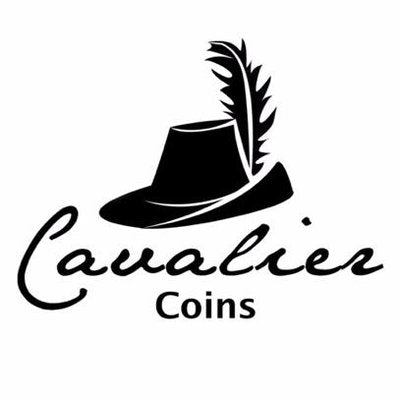The coins of George III's reign are a cornerstone of British numismatics. His incredible 60-year rule, from 1760 to 1820, saw the nation transform, and the coins of the era tell that story perfectly. From desperately needed copper tokens to the very first modern gold Sovereigns, each piece is a chapter in a tale of industrial revolution, war, and sweeping economic change. For anyone looking to understand the shift from historic to modern British currency, this is where it all begins.
A Reign Forged in Metal
George III sat on the throne during one of the most transformative periods in British history, and the coins minted under his name are metal artefacts of a nation in flux. His sixty years in power witnessed seismic shifts like the Industrial Revolution, the loss of the American colonies, and the long, draining Napoleonic Wars. Every one of these events left its mark on the nation's currency.
Try to think of each coin not just as money, but as a tangible piece of history. The early years of his reign were plagued by a severe coinage crisis. Things got so bad that counterfeit copper pieces often outnumbered official ones on the street. This chaos forced a kind of grassroots innovation, with merchants creating their own trade tokens just so they could do business. It was a time of true monetary desperation.
This period shows a fascinating side to currency: when the official systems break down, people will always find a way to make their own. The explosion of merchant tokens wasn't just about money; it was a sign of community resilience and the powerful drive to keep economic life going against all odds.
Later in the reign, as Britain emerged victorious from war and cemented its global power, the coinage started to reflect this newfound confidence and stability. This entire journey is captured in the coins themselves. Studying George III coins is like opening a window into the nation's soul. Understanding this historical arc is vital for any collector, as it gives context to the rarity, design, and meaning of each piece. You can see how this era fits into the bigger picture in our article covering a brief history of British coins.
What This Guide Covers
This guide is designed to walk you through the rich and complex world of coinage from this period. We will explore:
- The Great Coinage Crisis: We'll dig into the reasons behind the severe shortage of official money.
- Iconic Designs: We'll identify key coins, from the famous "Cartwheel" penny to the first Sovereigns.
- The 1816 Recoinage: You'll understand the monumental reform that laid the foundation for modern British money.
- Collector's Tips: We'll give you practical advice on grading, identifying, and valuing these historic coins.
Navigating the Great Coinage Crisis
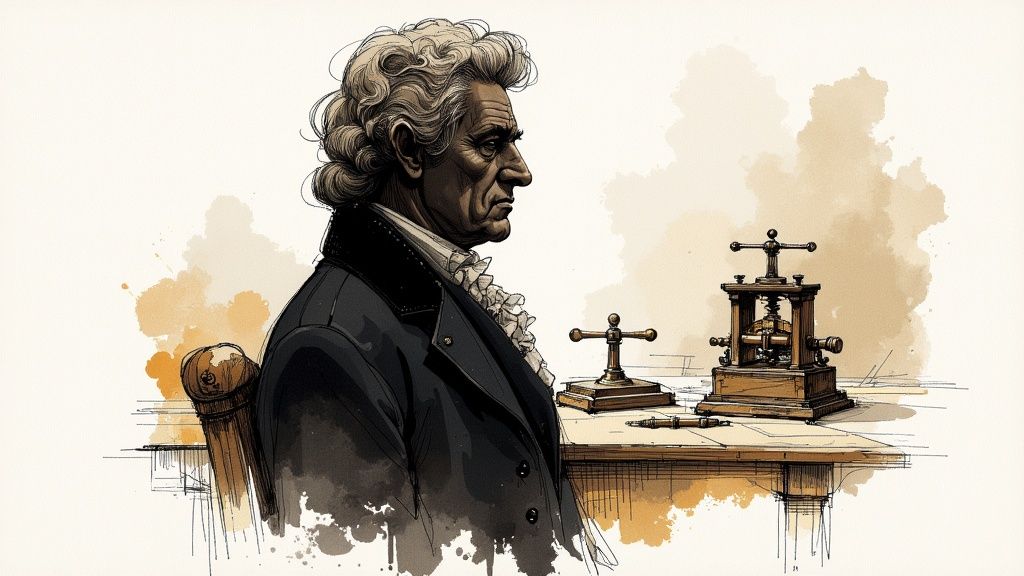
Can you imagine trying to pay for your daily bread when the coins in your pocket were more likely to be fake than real? For most people in the early part of George III’s reign, this wasn't just a bad dream; it was a daily, frustrating reality. This period became known as the ‘Great Coinage Crisis’, a time when Britain's entire monetary system was teetering on the edge of collapse.
The heart of the problem was a crippling shortage of officially minted small change, especially copper coins. With the Industrial Revolution firing on all cylinders, factories and workshops were popping up everywhere. This created a huge new class of workers who needed to be paid small, regular wages, but the Royal Mint simply couldn't keep up. This gap created a dangerous ‘monetary vacuum’ where legitimate currency was almost impossible to find.
Unsurprisingly, counterfeiters rushed in to fill the void. The market was flooded with unofficial, lightweight copies of farthings and halfpennies, often crudely made from cheap brass or lead. These fakes became so common that finding a genuine coin was a rare event, turning every simple transaction into a gamble. For merchants and labourers, just getting through the day was a struggle.
The Rise of Unofficial Tokens
With the government seemingly unable to find a solution, the people took matters into their own hands. Desperate for a reliable way to trade, private businesses, factory owners, and merchants started minting their own unofficial currency. These became known as Conder tokens, named after the man who first catalogued this fascinating piece of numismatic history.
But these tokens weren't forgeries in the usual sense. Instead of copying official designs, they often featured the name of the business that issued them, a picture of their factory, or even a political message. They were, in essence, a promise from a local merchant to accept the token as payment for goods and services.
This grassroots movement is an incredible story of survival and ingenuity. Faced with a failing monetary system, communities built their own micro-economies, running entirely on local trust and reputation. These tokens served a critical purpose, allowing wages to be paid and keeping the wheels of commerce turning when the official system had ground to a halt.
The widespread use of these merchant tokens demonstrates a powerful truth about currency. Money is ultimately a system of trust, and when the official system loses that trust, people will create alternatives to keep their economic lives moving forward.
The Scale of the Counterfeit Problem
The counterfeit issue wasn't just a minor headache; it was a full-blown national crisis that completely shattered public confidence in the currency. It's hard to overstate just how bad things got. A Royal Mint survey from 1787 revealed a jaw-dropping statistic: only about 8% of the copper halfpennies in circulation were genuine. That means a staggering 92% of the small change being passed from hand to hand was fake.
This flood of forgeries forced the Royal Mint to make a drastic decision. From 1775, it stopped producing copper coinage altogether, simply unable to compete. To fill this gap, it's estimated that a mind-boggling 600 tons of unauthorised trade tokens were produced near Birmingham alone between 1787 and 1797. Though technically illegal, the government had to turn a blind eye out of sheer necessity. The crisis was only properly addressed starting in 1797 when the industrialist Matthew Boulton was contracted to produce official coinage using his new steam-powered presses, marking a huge turning point for George III coins. You can dive deeper into this critical period and the copper coinage of George III on Coinweek.com.
This era of economic chaos was more than just a currency problem. It was the catalyst that forced the government to completely rethink its approach to minting, paving the way for the revolutionary changes and the Great Recoinage that would define the later years of George III’s long reign.
Identifying Key George III Coins and Designs
Diving into the world of George III coins is like stepping into a vast, ever-changing landscape. His reign stretched across six decades, a period of immense upheaval, and the coins produced reflect those dramatic shifts in technology, economics, and national identity.
To really get to grips with your collection, you need to be able to spot the key players. This guide will break down the most significant designs and denominations, from the humble copper coins of daily life to the gold that projected British power across the globe.
The Copper Workhorses
For the average person in Georgian Britain, copper coins were the absolute lifeblood of daily trade. But, as we've touched on, the early part of the reign was plagued by shortages and forgeries. This scarcity makes the official copper issues from this time both historically important and highly sought after today.
The most famous of these has to be the 1797 'Cartwheel' penny and twopence. These giants were struck by Matthew Boulton at his cutting-edge Soho Mint and were the very first regal coins made using steam power. Their immense size was a deliberate ploy to thwart counterfeiters; the penny contained exactly one ounce of copper, and the twopence a whopping two ounces. Their thick, raised rims earned them their famous nickname and make them instantly recognisable.
Later copper issues from 1806-1807 are also crucial for any serious collector. These halfpennies and pennies featured a more refined, draped bust of the King. But the copper shortage was a persistent headache, becoming so severe that it forced a complete halt to the minting of halfpennies after 1807. These last official halfpennies were the largest copper coins circulating in Britain at the time, marking the end of an era before the Great Recoinage of 1816. You can learn more about how economic pressures influenced coinage production strategies at Coincraft.com.
Silver Scarcity and Spanish Dollars
The story of George III's silver coinage is one of crisis and remarkable ingenuity. For a huge portion of his reign, the value of silver bullion was actually higher than the face value of the coins. This meant people would simply melt them down for a quick profit, making silver coins incredibly rare.
The government's solution was both pragmatic and bizarre: it imported enormous quantities of Spanish silver dollars (known as 8 Reales) and simply stamped its own mark over them. You can find these fascinating pieces with a small, oval hallmark of the King’s head stamped right onto the portrait of the Spanish monarch. It was a rough-and-ready fix to get currency moving again.
Later, Boulton's Soho Mint was brought in to overstrike these Spanish dollars entirely, creating the large Bank of England dollars of 1804. If you look closely at these, you can often see faint traces of the original Spanish design underneath the new British one—a feature that makes them a real favourite among collectors. It wasn’t until the Great Recoinage of 1816 that a full and stable supply of new silver shillings and sixpences was finally introduced.
The Evolution of Gold Coinage
Gold coins were the preserve of the wealthy, a symbol of Britain's economic might. During George III's time on the throne, the main gold coin was the Guinea, valued at 21 shillings. It featured various portraits of the King as he grew older.
A key variety that every collector wants is the "Spade" Guinea, struck between 1787 and 1799. It gets its name from the shield on the reverse, which has a pointed bottom that looks a bit like a spade. It’s probably the most iconic Guinea design of the entire series.
The biggest shake-up in gold coinage came right at the end of the reign. The Great Recoinage of 1816 officially replaced the Guinea with a new, slightly smaller gold coin valued at 20 shillings: the Sovereign. First issued in 1817, this coin introduced the world to Benedetto Pistrucci’s legendary design of St George slaying the dragon—a masterpiece still used on Sovereigns today. This was the birth of the modern British gold standard.
To help you get your eye in, it's useful to know the basic anatomy of these coins. The infographic below breaks down the essential features you'll find across George III's coinage.
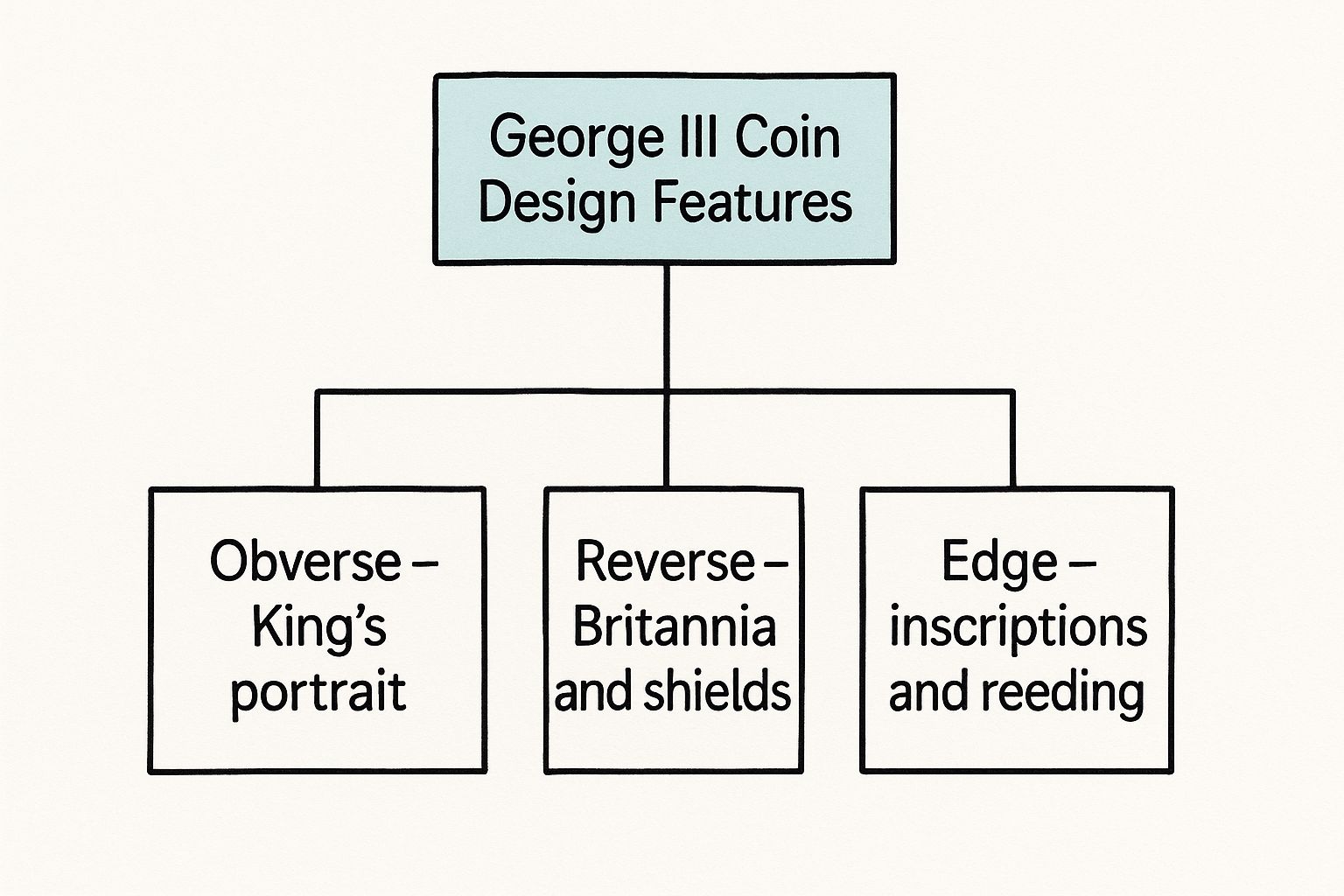
As you can see, a coin is simplified into three key areas: the obverse (the King's portrait), the reverse (the main design), and the edge. Each part holds vital clues for identification.
The sheer variety can feel overwhelming at first. This table gives you a quick-reference guide to the main denominations you'll encounter.
Major George III Coin Denominations and Features
| Denomination | Metal | Key Issue Years | Notable Features |
|---|---|---|---|
| Guinea | Gold | 1761-1813 | Iconic "Spade" reverse (1787-99); replaced by the Sovereign. |
| Sovereign | Gold | 1817-1820 | Introduced Pistrucci's St George and the Dragon design. |
| Bank of England Dollar | Silver | 1804 | Overstruck on Spanish 8 Reales; often shows undertype. |
| Shilling | Silver | 1763, 1787, 1816-20 | Scarce until the Great Recoinage of 1816. |
| Twopence & Penny | Copper | 1797 | The famous "Cartwheel" issues, known for their large size. |
| Halfpenny | Copper | 1770-75, 1799, 1806-07 | Production halted after 1807 due to copper shortages. |
This table covers the heavy hitters, but it's just the start. Each denomination has its own unique story and set of variations waiting to be discovered.
Portraits of a King
One of the most fascinating aspects of collecting George III coins is literally watching the King age through his portraits. The coins serve as a timeline of his life, from a young monarch full of promise to an elderly, ailing man.
Collectors generally group these portraits into several distinct bust types:
- Young Head (or First Bust): Seen on the earliest coins from the 1760s.
- Laureate Busts: Various portraits showing the King wearing a laurel wreath, common on later copper and gold issues.
- "Bull Head" Bust: A less flattering, much larger portrait from the final coinage issued after 1816, depicting the aged King.
Learning to recognise these portraits is a fundamental skill. It doesn't just help you date a coin; it connects you directly to the long and turbulent history of Britain's longest-reigning king.
Understanding the Great Recoinage of 1816
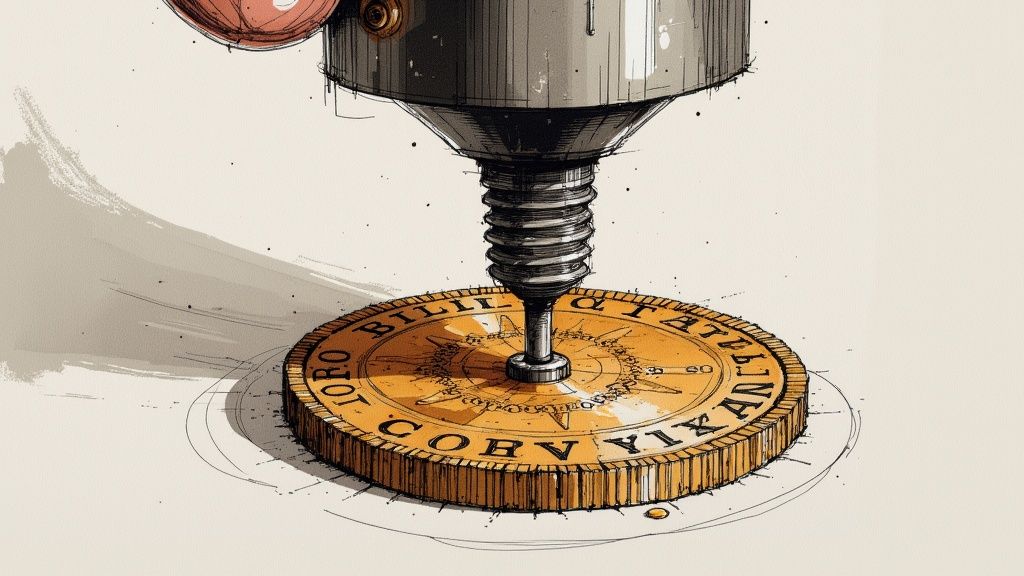
After decades of monetary chaos, plagues of counterfeit coins, and the pressures of war, Britain was finally in a position to get its financial house in order. With Napoleon defeated, the country could turn its attention inward, launching one of the most significant currency reforms in its history: the Great Recoinage of 1816.
This wasn't just a case of minting a few new coins. It was a complete overhaul of the nation's money, designed to once and for all end the crippling coin shortages that had hampered the economy for generations. Think of it as hitting the reset button on the entire currency system.
The core goal was simple but profound: restore public faith in the money they handled every day. For far too long, every transaction was a gamble. This reform promised a future where the coins in your pocket were genuine, their value was guaranteed, and trade could finally thrive.
The Gold Standard and Silver's New Role
The biggest change brought in by the 1816 Coinage Act was the official adoption of the gold standard. While gold had effectively been the standard for some time, this law made it official. Gold coins, especially the new Sovereign, became the sole measure of value—the ultimate yardstick of Britain’s wealth.
At the same time, the Act completely redefined the role of silver. In the past, silver coins were valued on the weight of the metal they contained. This was a huge problem, as they were often melted down whenever the price of silver bullion rose, causing yet more shortages.
The new system was clever. Silver was made a 'token' coinage, meaning its face value was set deliberately higher than the value of the silver it contained. This masterstroke removed any financial incentive to melt the coins down, ensuring they stayed in circulation to be used as small change for daily trade.
- Gold: Became the primary standard, a symbol of national wealth.
- Silver: Became a token currency, designed specifically for everyday circulation.
- Copper: Remained the workhorse for the smallest of transactions.
This clear, three-tiered structure created a stable and predictable monetary system that would power the British Empire for the next hundred years. It was a currency built for an industrial and global powerhouse.
The Birth of the Iconic Sovereign
The undeniable star of the Great Recoinage was a brand-new gold coin, first struck in 1817 and worth precisely 20 shillings. This was the Sovereign, a coin designed from the ground up to be an icon of British power and stability.
To create a design worthy of its status, the Royal Mint brought in a brilliant Italian gem engraver, Benedetto Pistrucci. He delivered a timeless masterpiece for the reverse: a breathtaking, neoclassical image of St George on horseback, slaying the dragon. This was worlds away from the stuffy shields and coats of arms that had dominated coins for centuries.
The St George and the Dragon design was more than just art; it was a powerful piece of national branding. It perfectly captured Britain's triumph over the chaotic forces of Napoleonic France and its emergence as the world’s dominant power. It was a statement of victory and confidence, struck in solid gold.
The design was an instant classic, so perfectly capturing the national mood that it is still used on British Sovereigns over 200 years later. The stability achieved during George III's reign laid the foundation for this new golden era. This was built upon by his successors, with mintages growing to fuel a booming empire. You can explore how Sovereign production evolved through the 19th century at BullionByPost.co.uk.
The later George III coins produced under this new system are tangible symbols of this hard-won stability. They represent the end of a long period of uncertainty and the dawn of a new age of British financial confidence.
A Practical Guide to Collecting George III Coins
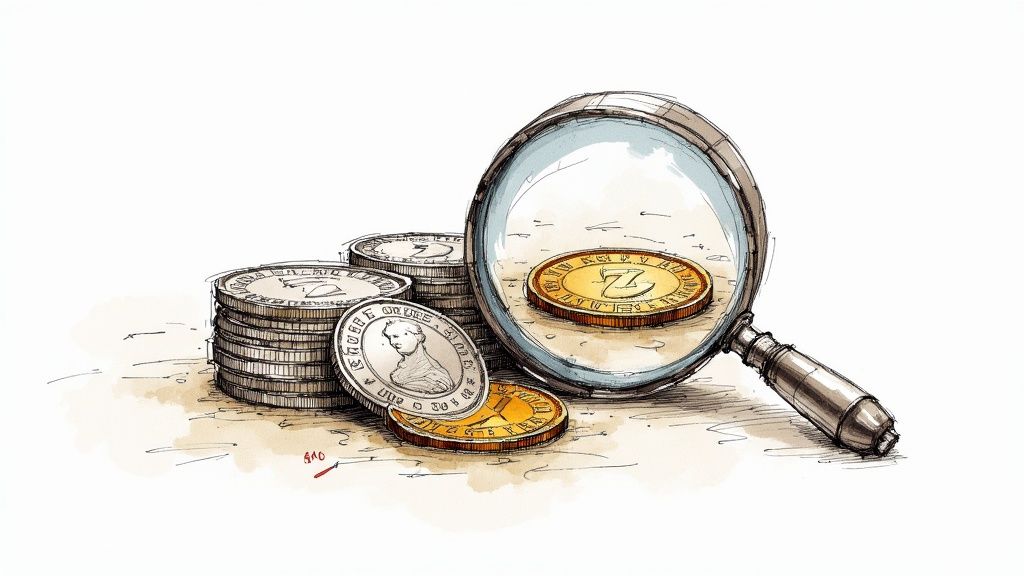
Knowing the history of George III’s coinage is one thing, but actually building a collection is where the real fun begins. This is where we take all that fascinating context and turn it into a truly rewarding hobby. Getting started can feel like a big step, but if you get to grips with a few core ideas, you can start building your collection of these remarkable coins with confidence.
The single most important factor you’ll come across is grading. You can think of a coin’s grade as its official report card – a measure of its condition. This is the main driver of its value, determining whether a coin is worth a few pounds or many thousands. A well-worn piece that has passed through countless pockets might be graded as 'Fine' (F), while a perfect specimen that looks like it just left the mint could be 'Uncirculated' (UNC). The price gap between those two grades for the exact same coin can be enormous.
Learning to eyeball a coin's condition is a skill every collector needs. It means looking for wear on the highest points of the design, like the details in the King’s hair or on Britannia’s shield. Once you can spot these subtle differences, you’ll understand why coins are priced the way they are and avoid paying too much for an over-graded piece.
Thinking Like a Numismatist
Beyond a coin's raw condition, a seasoned collector—or numismatist—will look at several other factors to figure out just how rare and desirable it is. One of the biggest is mintage, which is simply how many coins of a specific date and type were ever produced. As you’d expect, a lower mintage figure nearly always means a rarer, more valuable coin.
A silver shilling from 1787, for instance, is far more common than the famous "Northumberland" shilling of 1763, which had a very small mintage. Knowing these "key dates" is vital. It’s what helps you spot a rare gem that others might just pass over, elevating your collection from a simple accumulation of coins into a thoughtfully curated set.
Another key area is learning to spot the different varieties. This includes:
- Portraits: Getting to know the difference between the 'Young Head', the various 'Laureate' busts, and the final 'Bull Head' portrait is fundamental.
- Mint Marks: These aren't as common on George III coins as in earlier periods, but some issues from the Soho Mint have specific identifying marks.
- Errors and Varieties: Keep an eye out for unique features like overstrikes, where a new design is stamped right over an older coin. These tell a fascinating story.
Provenance—a coin's documented ownership history—can also add huge value and interest. A piece that can be traced back to a famous old collection carries a story with it, making it more than just metal. It becomes a tangible link to the collectors who cherished it in the past.
Common Pitfalls to Sidestep
As you start your collecting journey, there are a few common mistakes that trip up newcomers. Knowing what they are can save you both money and a lot of frustration down the line. The biggest trap is buying a coin that's been improperly cleaned. Cleaning a coin with anything abrasive leaves tiny, hairline scratches on its surface, permanently damaging it and tanking its value.
There's a world of difference between professional conservation and a harsh polish. A coin with its original, untouched surfaces, even with a bit of natural toning, is almost always more desirable to serious collectors than one that’s been scrubbed shiny but is secretly damaged. Learning to spot the tell-tale signs of cleaning is a crucial skill. For a bit more guidance, taking a look at these seven tips for buying collectable coins can really help you understand what to look for.
Finally, always try to buy from reputable sources. Established dealers, well-known auction houses, and numismatic societies are your best friends in this hobby. They offer expertise, guarantee authenticity, and can give you invaluable advice. By building relationships with dealers you trust, you’ll make smarter buys and find the pieces that truly make your collection special. Arm yourself with this knowledge, and you’ll be well on your way to building a George III collection you can be truly proud of.
Common Questions About George III Coins
The world of George III coins is fascinating, but it can also be a bit overwhelming. His incredibly long reign, coupled with massive economic shifts and sweeping changes to the coinage, creates a rich but sometimes confusing collecting area. Whether you're just starting out or have been a numismatist for years, questions are bound to come up.
This section tackles some of the most frequent queries we hear from collectors. Getting these basics down will not only help you understand specific coins but will give you a much deeper appreciation for the history behind them.
What Is the Most Valuable George III Coin?
While the market is always changing, the real heavy hitters in the George III series are usually high-grade gold coins and exceptionally rare pattern pieces. These patterns were essentially design prototypes, never meant for the public's pockets. The legendary 1817 'Three Graces' pattern crown, for example, is a true icon of British numismatics and can fetch six-figure sums whenever one makes a rare appearance at auction.
Another top-tier rarity is a high-condition 1770 Gold 5 Guineas piece. For coins that are a bit more within reach, the famous 1797 'Cartwheel' twopence can be surprisingly valuable if found in pristine, uncirculated condition, thanks to its sheer size and historical importance. Ultimately, any coin's value boils down to a few key things:
- Low Mintage: Simply, how many were made in the first place.
- Precious Metal Content: The intrinsic value of the gold or silver.
- Historical Context: Its link to major events like the Great Recoinage.
- Superb Condition: The grade of the coin is everything.
How Can I Spot a Counterfeit George III Coin?
Learning to spot forgeries from the era is a skill in itself. In fact, many of these contemporary counterfeits are now collected in their own right! These were often crudely made from brass or other cheap metals to pass as official copper, silver, or even gold coins.
When you're examining a coin, look for the tell-tale signs of a fake. You might see soft, 'mushy' details on the King's portrait or the lettering, which often happens when a coin is cast from a mould instead of being properly struck. Other giveaways include tiny bubbles on the surface or a weight that just feels wrong. Genuine coins, especially those from Matthew Boulton’s high-tech Soho Mint, have a crisp, sharp strike and a quality finish that's hard to replicate.
For any George III coin of significant value, the best approach is always professional authentication. Getting it checked by a reputable third-party grading service or a trusted dealer gives you peace of mind and confirms the coin’s authenticity and grade.
What Is a Good Starting Point for a New Collector?
If you're just dipping your toes into this era, the copper coinage is an excellent place to start. The 1797 'Cartwheel' penny or the later 1806-1807 halfpennies are fantastic choices. They are historically important, easy to find, and won't break the bank in lower grades, giving you a chance to own a genuine piece of the past without a huge investment.
Another great entry point is the silver coinage struck after the 1816 recoinage, like the shillings and sixpences. These were made in huge numbers and are perfect for learning to identify different dates and the famous 'bull head' portrait of the elderly king. Starting with these common coins helps you build a solid foundation in grading and identification before you move on to rarer, more valuable pieces. That knowledge is crucial, and you can learn more about how to value old English coins in our detailed guide.
At Cavalier Coins Ltd, we're passionate about helping collectors at every stage of their journey. Explore our extensive selection of historic coins and banknotes to find the next perfect piece for your collection. https://www.cavaliercoins.com
